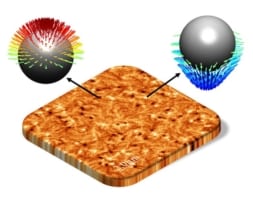
The interface between two facets of an artificial material known as a “Weyl phononic crystal” can not only negatively refract an airborne sound wave, it does so without reflecting it at all. This hitherto unseen wave behaviour could be important for fundamental studies of condensed matter and find many practical applications in acoustics, electronics and optics too.
Refraction occurs when waves pass from one medium to another and change direction. Although part of the wave’s energy passes through the interface between the two different media during this process, the rest of it is inevitably reflected from the interface. Refraction and reflection are two fundamental interfacial wave phenomena and are exploited when making devices like optical lenses.
In naturally-occurring materials, incident and refracted waves always find themselves on opposite sides of the normal (an imaginary line perpendicular to the interface). However, this is not the case in artificially engineered “negative refractive index” materials (that bend light in the opposite way to normal materials). Here, the refracted wave can emerge on the same side of the normal as the incident one.
Such “metamaterials”, which were put forward in theory in 1968 by Victor Veselago and then actually engineered at the beginning of this century thanks to pioneering work by John Pendry, have allowed for important advances in optics, acoustics and plasmonics (a relatively new field that is based on light-electron interactions in metals). Reflection unsurprisingly occurs in these materials too, but it is unwanted since it reduces the efficiency of devices made out of them.
Topological quantum matter
Zero reflection of light is not seen in natural optical materials, but it does occur in some emerging classes of topological quantum matter – when electrons are quantum-mechanically reflected, for instance. An example of such a material is a topological insulator, which is electrically insulating in its interior but conducting on its surface thanks to electronic waves called topologically protected surface states (induced by the topology of the material’s bulk electronic band structure).
Researchers led by Chunyin Qiu and Zhengyou Liu have now taken inspiration from another recently-discovered topological quantum material: a Weyl semimetal. The topological surface states in this material cannot propagate in all directions but are limited to a certain range of directions. These form so-called Fermi arcs, and because they do not include the direction in which reflection would normally occur, it is inherently forbidden.
Acoustic analogue of a Weyl semimetal
In their work, which they report in Nature, Qiu and colleagues studied an acoustic analogue of a Weyl semimetal by making “woodpile” phononic crystals comprising stacked trilayer-based building blocks. “Each trilayer unit consists of thee identical square epoxy rods that are twisted anticlockwise by 2π/3 along the vertical direction layer-by-layer and associated with a triangular lattice in the horizontal plane,” explains Qiu.
“We found that airborne acoustic waves could be negatively refracted at the interfaces between two adjacent facets of a woodpile crystal without being reflected,” he says. “Ours is also the first experimental observation of negative refraction for topological surface states,” he tells Physics World.

What can you do with a Weyl semimetal?
This combination of negative refraction and zero reflection could be put to good use in many applications. One example: improving the resolution of ultrasonic imaging and testing, says Baile Zhang of Nanyang Technological University in Singapore in a related Nature News and Views article. Such “topological acoustics” might also be used to improve biomedical microfluidic devices such as those that trap, sort and deliver cells and drug particles. “Reflection-free acoustic waves are strongly desirable in such applications because reflections at the interfaces and sharp corners of microfluidic channels are currently a huge limitation to device efficiency,” he writes.



